MARIANI’S
Virtual Gourmet
April
22, 2018
NEWSLETTER

THE ITALIAN RESTAURANT,
AMADA, ARIZONA
Photo by John Margolies (Library of Congress)
❖❖❖
IN THIS ISSUE
QUÉBEC
By Edward R. Brivio
NEW YORK CORNER
NANA RESTAURANT AND BAR
By John Mariani
NOTES FROM THE WINE CELLAR
2015 BURGUNDIES
By Geoff Kalish
❖❖❖
By Edward Brivio
Photos by Robert Pirillo
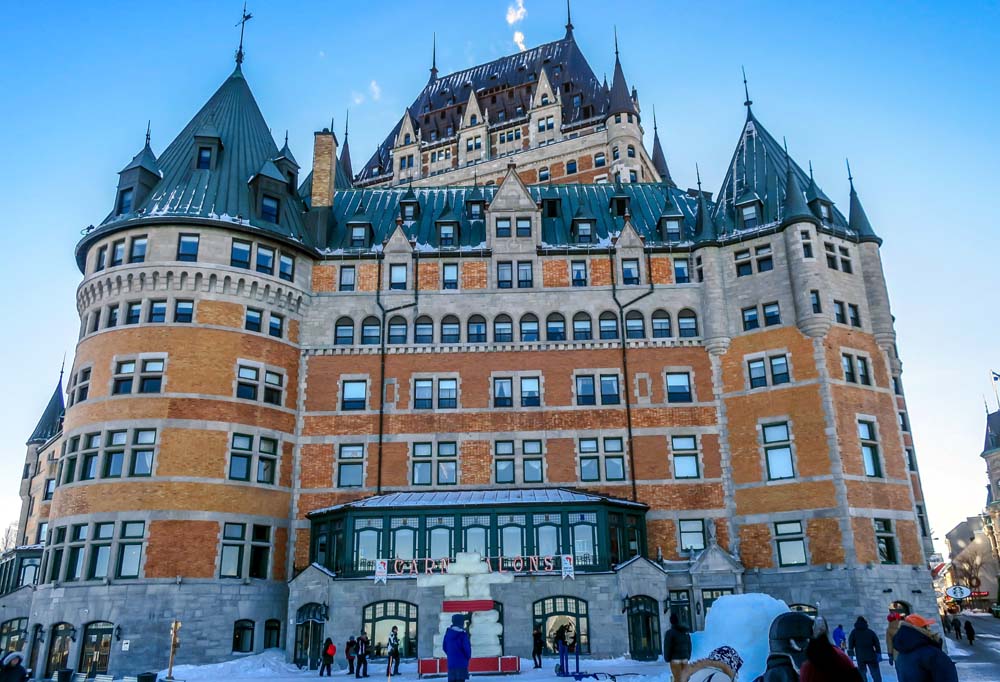
Fairmont Le Château Frontenac
Blanketed
in snow during the winter months, Vieux Quebec,
founded in1608 by Samuel de Champlain, is not
only one of the oldest European settlements in
North America but also the most charming. Joined
by a steep funicular, its upper and lower town
are each a warren of cobble-stone streets filled
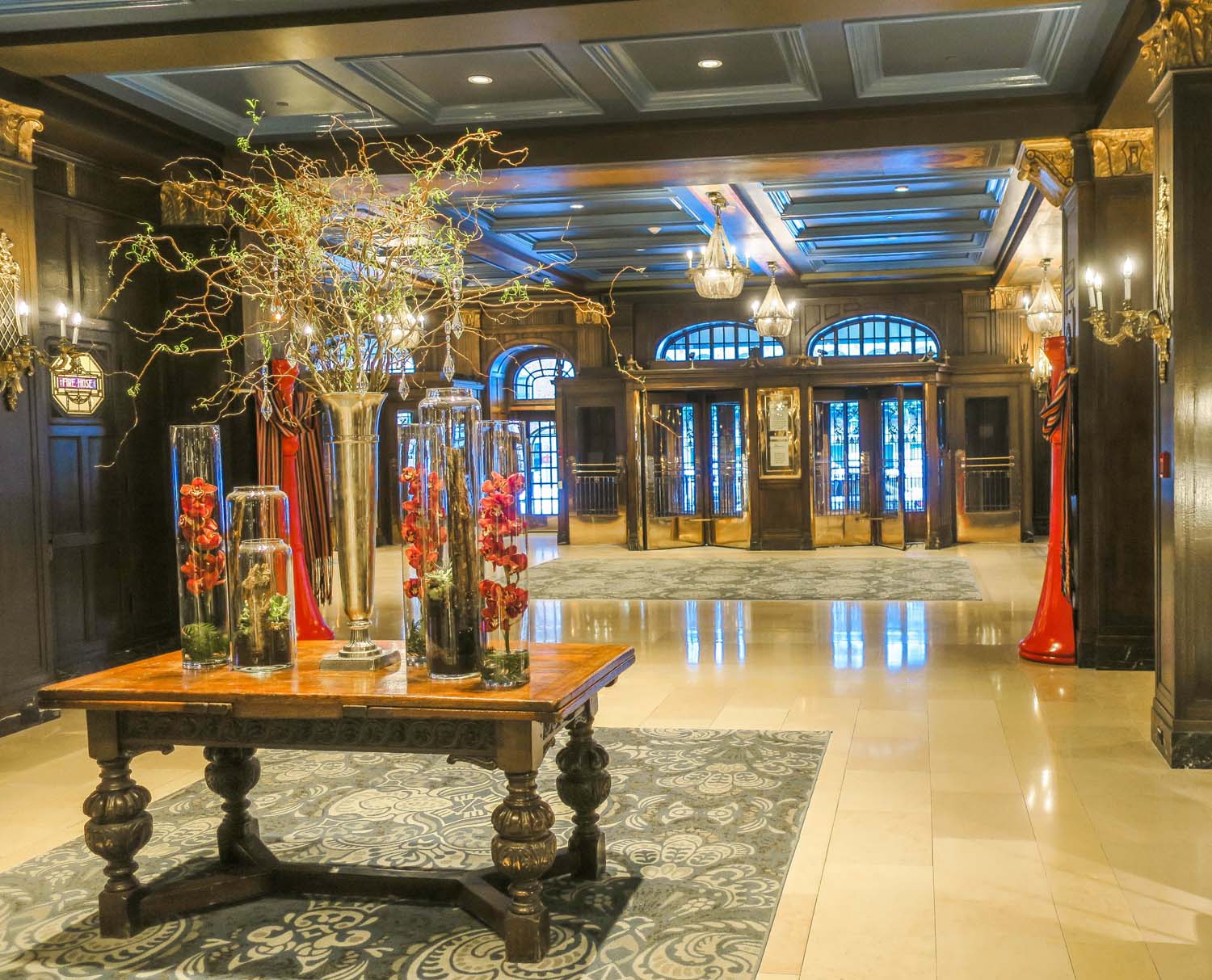 with
mansard-roofed stone townhouses from the 17th
and 18th centuries, giving it a pleasing
architectural harmony. Add to this the original
fortified ramparts that still surround the Old
Town, and it’s easy to see why it was declared a
World Heritage Site by UNESCO in 1985. In the
evening, the view of the lower town --festively
lit for Quebec’s annual Winter Carnival--from
the upper town's Promenade was enchanting.
with
mansard-roofed stone townhouses from the 17th
and 18th centuries, giving it a pleasing
architectural harmony. Add to this the original
fortified ramparts that still surround the Old
Town, and it’s easy to see why it was declared a
World Heritage Site by UNESCO in 1985. In the
evening, the view of the lower town --festively
lit for Quebec’s annual Winter Carnival--from
the upper town's Promenade was enchanting.
The first, and grandest, of the
château-style hotels erected by The Canadian
Pacific railroad, the Château Frontenac (now the
Fairmont Le Château Frontenac was built to provide
travelers with luxurious lodgings on a par with
their opulent life style. Often cited as the “most
photographed hotel in the world,” this grande dame
of Quebec hostelries is celebrating its 125th
anniversary.
The original hotel as designed
by architect Bruce Price, who drew inspiration
from the Renaissance chậteaux of the Loire valley,
was a true chateau, planned around an inner
courtyard, with massive circular turrets and
polygonal towers. Renovated many times since its
opening in 1893, it still retains an overall
harmony with its asymmetrical profile and numerous
wings, all with similar steeply pitched roofs,
corbels, decorative, two-story dormer windows,
tall chimneys and brick-red outer walls of
Scottish Glenboig stone, all held together by a
tall central tower, added in 1926. The sprawling,
fortress-like structure we see today is an
imposing reminder of the strategic importance of
this site atop Cap-Diamant with its commanding
view of the St. Lawrence river at its confluence
with the St. Charles.
The Seven Years’ War fought
between France and England for supremacy in Canada
ended in a decisive battle in Quebec on the Plains
of Abraham, just to the its southwest. where some
1,200 men died and both the French and English
generals, Montcalm and Wolfe, were mortally
wounded.
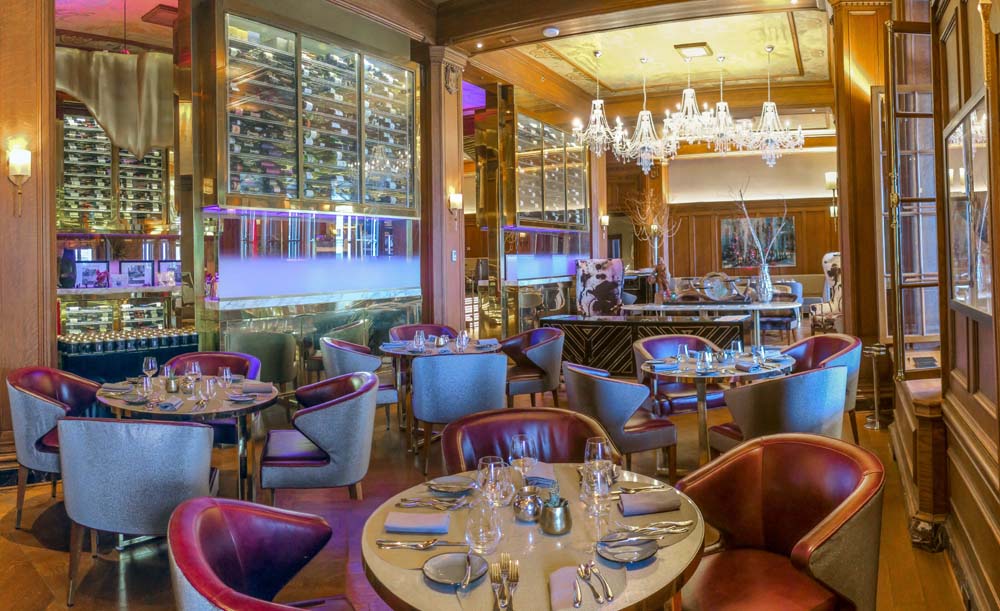 As we
turned off the snow-covered Rue St.-Louis, under
the arched porte cochere and into the courtyard,
through the heavy brass revolving doors of the
entrance, I found the warm, welcoming lobby bathed
in a golden glow beneath its coffered ceiling.
Rich mahogany paneling, fluted pilasters topped
with gilded Corinthian capitals, crystal
chandeliers, floor-to-ceiling drapes and a
gleaming white marble floor and a dramatic double-
staircase with an ornamental wrought-iron
balustrade. All
give one the feeling of having "arrived" somewhere
out of the ordinary, this impression of being a
privileged chatelain
reinforced by the hotel's capable, efficient staff
who fulfilled our every request with grace and
alacrity.
As we
turned off the snow-covered Rue St.-Louis, under
the arched porte cochere and into the courtyard,
through the heavy brass revolving doors of the
entrance, I found the warm, welcoming lobby bathed
in a golden glow beneath its coffered ceiling.
Rich mahogany paneling, fluted pilasters topped
with gilded Corinthian capitals, crystal
chandeliers, floor-to-ceiling drapes and a
gleaming white marble floor and a dramatic double-
staircase with an ornamental wrought-iron
balustrade. All
give one the feeling of having "arrived" somewhere
out of the ordinary, this impression of being a
privileged chatelain
reinforced by the hotel's capable, efficient staff
who fulfilled our every request with grace and
alacrity.
Our
room had a comfortable king-size bed, an
immaculate marble-clad bathroom, and most of all,
a large window overlooking the Dufferin Terrace
Promenade, the lower town, and the massive ice
floes jamming the St. Lawrence river. What a
splendid view, especially at night with the
shimmering lights of the town of Levis across the
way, and the Québec/Levis ferries threading their
way laboriously through the ice-clogged river.
The hotel's signature
restaurant, called simply Champlain (above), has
two beautiful wood-paneled dining rooms with a
luxurious contemporary feel. One long glass wall
is used to display a the best bottles on the wine
list. Gorgeous leather arm-chairs surround
well-spaced, well-appointed tables. We sat in the
upper room, where large windows overlooked the
Dufferin Terrace.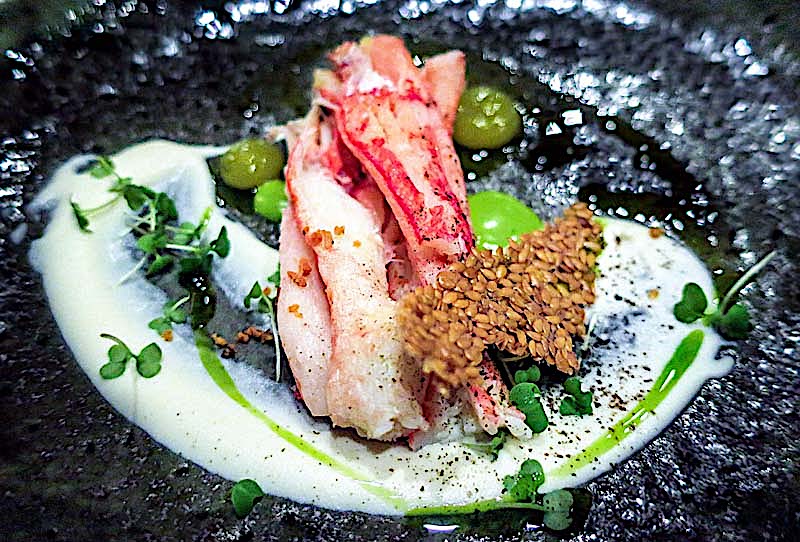
Our waiter suggested the
five-course tasting menu ($77), most of which is
available separately à la carte. Snow crab from
Ste.-Thérèse de Gaspé (right) with pine tree mayonnaise
was a simple, refreshing dish as an appetizer,
with a flax-seed cracker adding an interesting
crunch. Arctic char with mushroom mousse followed.
Salmon was cooked sous vide--my least favorite
cooking method--which rendered it slightly rubbery
and rather bland; a mushroom mousse, and a
wild-carrot horseradish fortunately provided some
real flavor.
Things picked up dramatically
with seared foie gras-- crispy on the outside and
buttery within-- from Marieville just outside of
Montreal--served with marinated Northern fruit:
cranberries, blueberries and maple caramelized
almonds.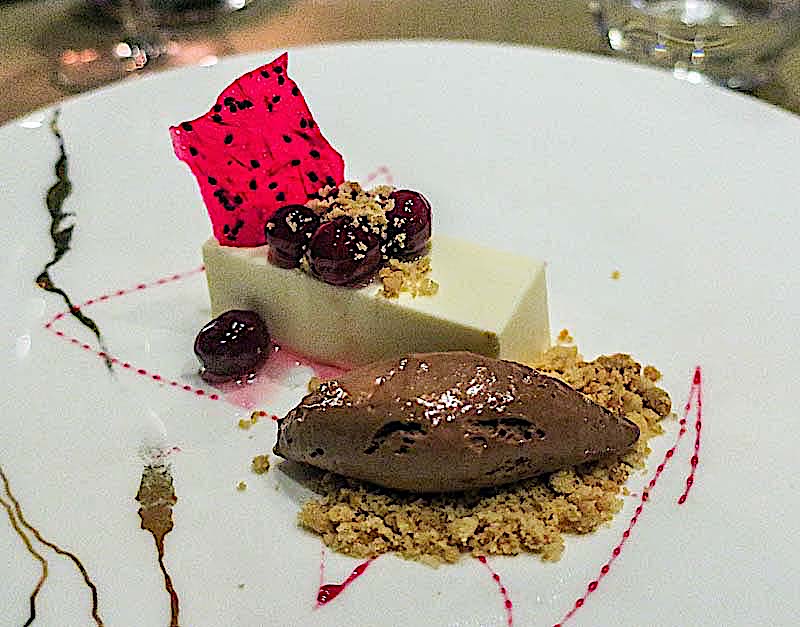 Roasted
lamb filet with rutabaga puree, hazelnut mushrooms
and glazed beets was all together fine. Our
dessert was Melilotus panna cotta with bitter
chocolate ice cream (left). Melilotus is another name
for sweet clover, which gave a delicious hint of
new cut grass to the dessert.
Roasted
lamb filet with rutabaga puree, hazelnut mushrooms
and glazed beets was all together fine. Our
dessert was Melilotus panna cotta with bitter
chocolate ice cream (left). Melilotus is another name
for sweet clover, which gave a delicious hint of
new cut grass to the dessert.
Five wines accompanied the
meal: a delicious, uncomplicated Sauvignon Blanc
from Domaine de Haut Bourg in the Loire with the
crab; a round, flavorful Canadian Chardonnay from
Inniskilin with the char; and a luscious, sweet,
and slightly botrytized 2010 Sauternes from
Château Amajan des Ormes was a perfect
accompaniment to the foie gras. Along with the
lamb came a 2015 Château Ste. Michelle Indian
Wells Red Blend from Washington state, made from
seven varietals: Syrah, Merlot, Malbec, Grenache,
Cabernet Franc, Mourvèdre, and Petit Verdot, that
was full-bodied and delicious without being
overdone. And with dessert, the justly renowned
Vidal Ice Wine from Inniskilin, its luscious
sweetness balanced by a fine acidity, the wine
that put Canada on the oenological map.
Appetizers $11-$22, main courses
$25-$36, desserts $11-$12. (All prices are in
$US.)
A
less formal dining venue is the hotel's Bistro Le Sam,
with a brightly lit, spacious lower room and
another a couple of steps up. Here we
were given what must be the best seat in the
house, a large demi-lune banquette in royal blue
set right up against a window with a full view of
the Saint Lawrence below. Superb Oysters
Rockefeller, just heated through, with spinach and
a touch of foie gras for added richness, got lunch
off to a splendid start, as did a four-square,
satisfying soupe
à l'oignon, which the snow drifts outside
and the frigid weather–three degrees that
day--seemed to call for. Next came a lovely,
textbook confit
de canard (right)
with delicious rösti potatoes,
and the day's special, osso bucco (which
needed salt) with dense and chewy gnocchi that
even the rich brown gravy could not redeem. Le
Quebec, a wonderful maple-flavored version of
Paris-Brest, and a layered chocolate gâteau with
three different intensities of chocolate, brought
things to a delicious close.
Appetizers
$8-21, Mains: $15-$32, desserts $7-$8.
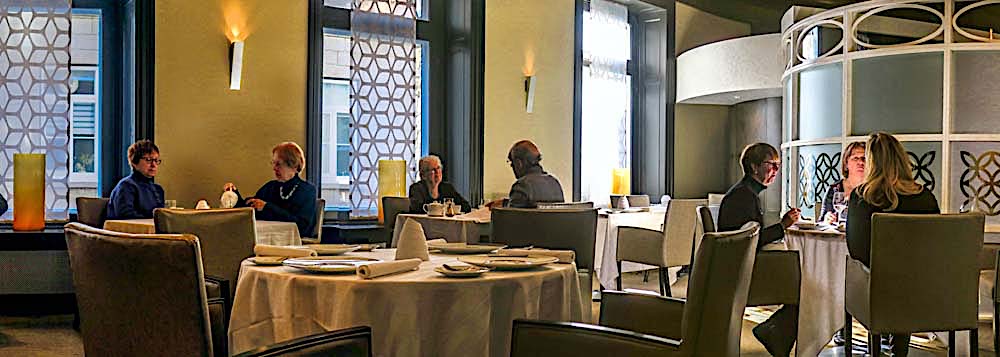 Dining outside the hotel,
one could do no better than to choose L'Initiale (55 rue St.-Pierre, 418-694-1818), located in a former bank
building with a rather mercantile, yet monumental
exterior. The main dining room (above) at
this member of the Relais and Château collection
is a chic, understated, contemporary space, and
its muted palette and pared-down, elegant décor
allow the artfully arrange colorful dishes to
stand out in all their glory.
Dining outside the hotel,
one could do no better than to choose L'Initiale (55 rue St.-Pierre, 418-694-1818), located in a former bank
building with a rather mercantile, yet monumental
exterior. The main dining room (above) at
this member of the Relais and Château collection
is a chic, understated, contemporary space, and
its muted palette and pared-down, elegant décor
allow the artfully arrange colorful dishes to
stand out in all their glory.
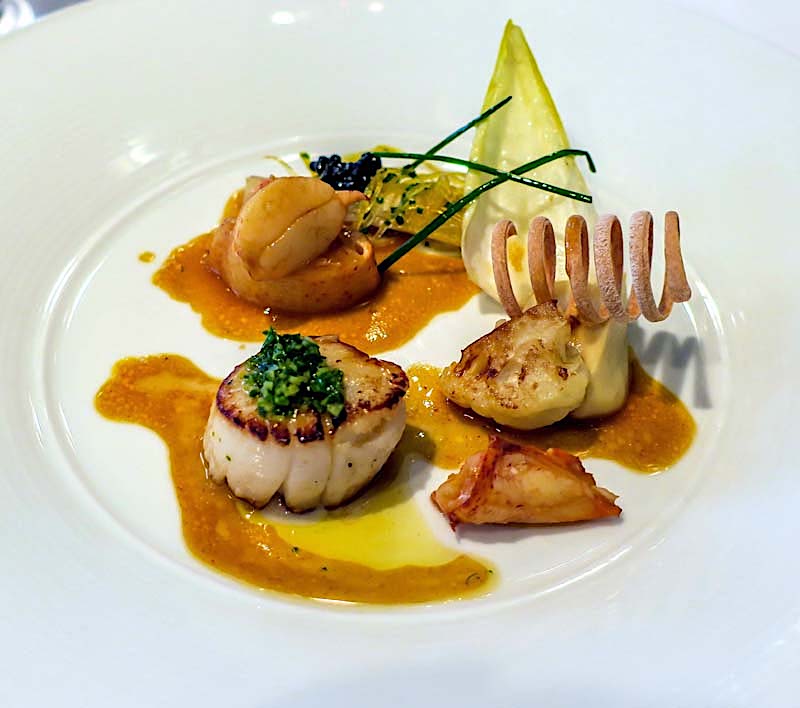 Overseeing
the front of the house is Madame Rolande Leclerc,
the epitome of Gallic chic and graciousness, while
her husband, Yvan Le Brun, mans the pots and pans
in the immaculate kitchen with its small brigade of
four chefs.
Overseeing
the front of the house is Madame Rolande Leclerc,
the epitome of Gallic chic and graciousness, while
her husband, Yvan Le Brun, mans the pots and pans
in the immaculate kitchen with its small brigade of
four chefs.
At lunch, our dégustation
started with foie gras in various guises-- en terrine
and as a mousse with warm, freshly made brioche,
thin slices of quince, and a small tuile
made from the duck juices and reduced to a thin
sheet, an ingenious idea that was also delicious.
The chef's creativity can be slightly playful, but
always with a sureness of touch and a finesse,
each plate like a variation on a theme.
Our next course was shellfish:
a roast scallop and morsels of lobster napped with
lemon beurre
blanc (left),
alongside endive, a puree of cauliflower and
mullet roe. The shellfish were both perfectly
cooked as well as beautifully arranged. A curlicue
grissini added
a whimsical twist.
The main course, or Résistance as
it's referred to here, was halibut 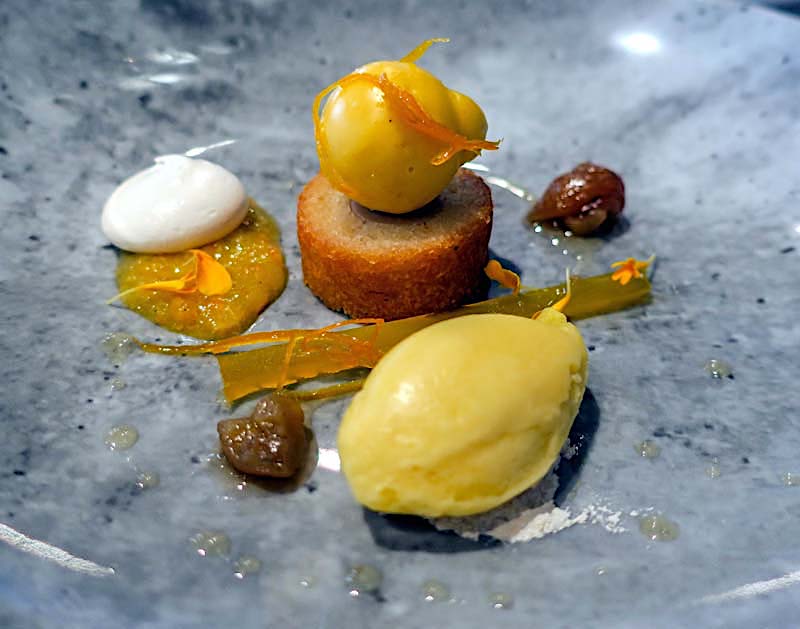 meunière
with hen-of-the-woods mushrooms and pearl onions.
The halibut was simply a marvel. I don't think
I've ever had a piece of fish so carefully cooked
and delicious, firm yet juicy, tender yet cooked
through, and the mushrooms were a savory
accessory.
meunière
with hen-of-the-woods mushrooms and pearl onions.
The halibut was simply a marvel. I don't think
I've ever had a piece of fish so carefully cooked
and delicious, firm yet juicy, tender yet cooked
through, and the mushrooms were a savory
accessory.
Desserts were a trio of lemon
delights (right),
lemon ice cream, super lemony but not astringent,
and a sphere of lemon cream in a thin candy shell
that was another marvel, as well as candied zest
and candied chestnuts, and a chocolate
extravaganza, once again with five delicious
variations on the main theme, and a scoop of
passion fruit ice cream added for contrast.
This is contemporary haute
cuisine at its best, while the attentive Madame
Rolande, who lovingly describes the components of
each course, and the flawless, seamless service
made a memorable meal even more so.
Lunch was $46, a bargain for
food of this caliber, and with it we drank an
exemplary 2016 Sancerre Les Caillotes ($12) from
Jean Maxime Roger, followed a 2009 Baron des
Galets St. Julien ($18) well-balanced, with good
structure but still fresh and youthful.
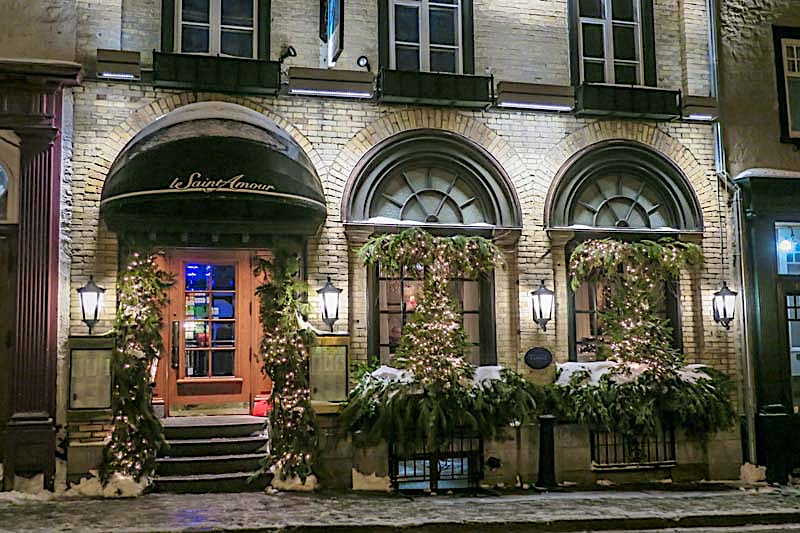 Chef
Jean-Luc Boulay has been delighting guests since
1978 at his signature restaurant Le Saint
Amour (48
Rue Sainte-Ursule; 418-694-0067) located in an historic 18th
century townhouse in the upper-town. In late
January the façade and its window-boxes, still in
their holiday finery, were adorned with a
profusion of fresh evergreen boughs powdered with
snow. We dined in the front, a rather nondescript
dining room. If only someone had thought to seat
us in the gorgeous backroom, which is part red
Belle Epoque salon and part Victorian
conservatory.
Chef
Jean-Luc Boulay has been delighting guests since
1978 at his signature restaurant Le Saint
Amour (48
Rue Sainte-Ursule; 418-694-0067) located in an historic 18th
century townhouse in the upper-town. In late
January the façade and its window-boxes, still in
their holiday finery, were adorned with a
profusion of fresh evergreen boughs powdered with
snow. We dined in the front, a rather nondescript
dining room. If only someone had thought to seat
us in the gorgeous backroom, which is part red
Belle Epoque salon and part Victorian
conservatory.
Dinner began with a delicious
terrine of foie gras (below) sourced from the highly
reputed Ferme
du Canard goulu in Saint-Apollinaire across
the St. Lawrence to the southwest. It was served
with candied black currants and grilled brioche. A
deceptively simply named Shellfish bisque was a
velvety smooth, creamy version with a heavenly
aroma and profound flavor.
We followed these
with sweetbreads and a Turlo Farm squab. The
sweetbreads were served with a large wild shrimp,
excellent gnocchi and a celeriac puree, all bathed
in a delicious creamy sauce based on apple cider
with just the slightest bit sweet to complement
the subtle sweetness of the ris-de-veau.
The squab, from a farm in the tiny hamlet of St.
Gervais arrived as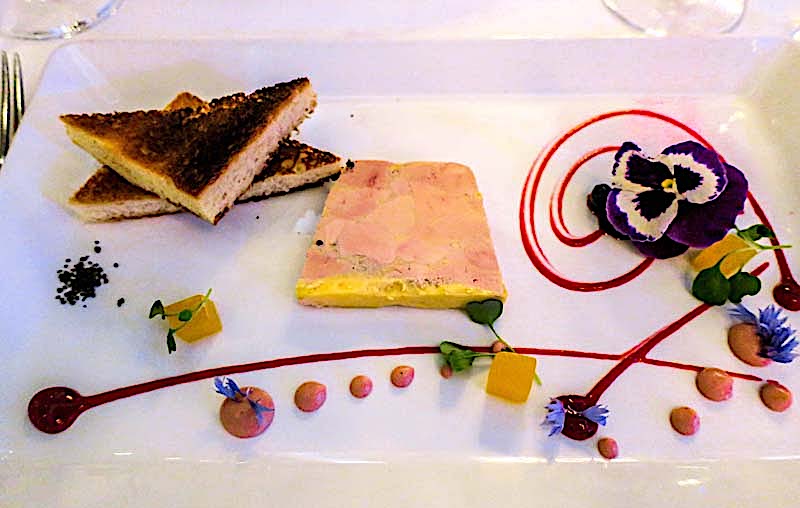 a leg
confit stuffed with foie gras --talk about gilding
the lily- alongside the breast cooked to a precise
medium rare, with seared fava beans and wild
mushrooms in a rich, deep brown reduction of the
bird’s natural juices flavored with the giblets
and a bit more foie gras.
a leg
confit stuffed with foie gras --talk about gilding
the lily- alongside the breast cooked to a precise
medium rare, with seared fava beans and wild
mushrooms in a rich, deep brown reduction of the
bird’s natural juices flavored with the giblets
and a bit more foie gras.
After all this wonderful food,
we both shared one dessert, aptly named L'Oasis, comprised of a slice of
seared pineapple stop a round of cake, with
mascarpone Chantilly cream and a scoop of passion
fruit sorbet--the perfect finale, rich yet light,
sweet yet thoroughly refreshing.
We drank a 2015 Morgon from
Jean-Paul Brun Domaine des Terres dorées
($53), one
of Beaujolais’ most traditional examples from one
of its best vignerons. Now that most red
Burgundy has become prohibitively expensive, I’m
delighted at what a good, rich, wallet-friendly
red wine Gamay--especially in the crus Beaujolais--
can produce when handled with care.
Soups
and starters: $14-$28, mains $36-$40, desserts
$12.
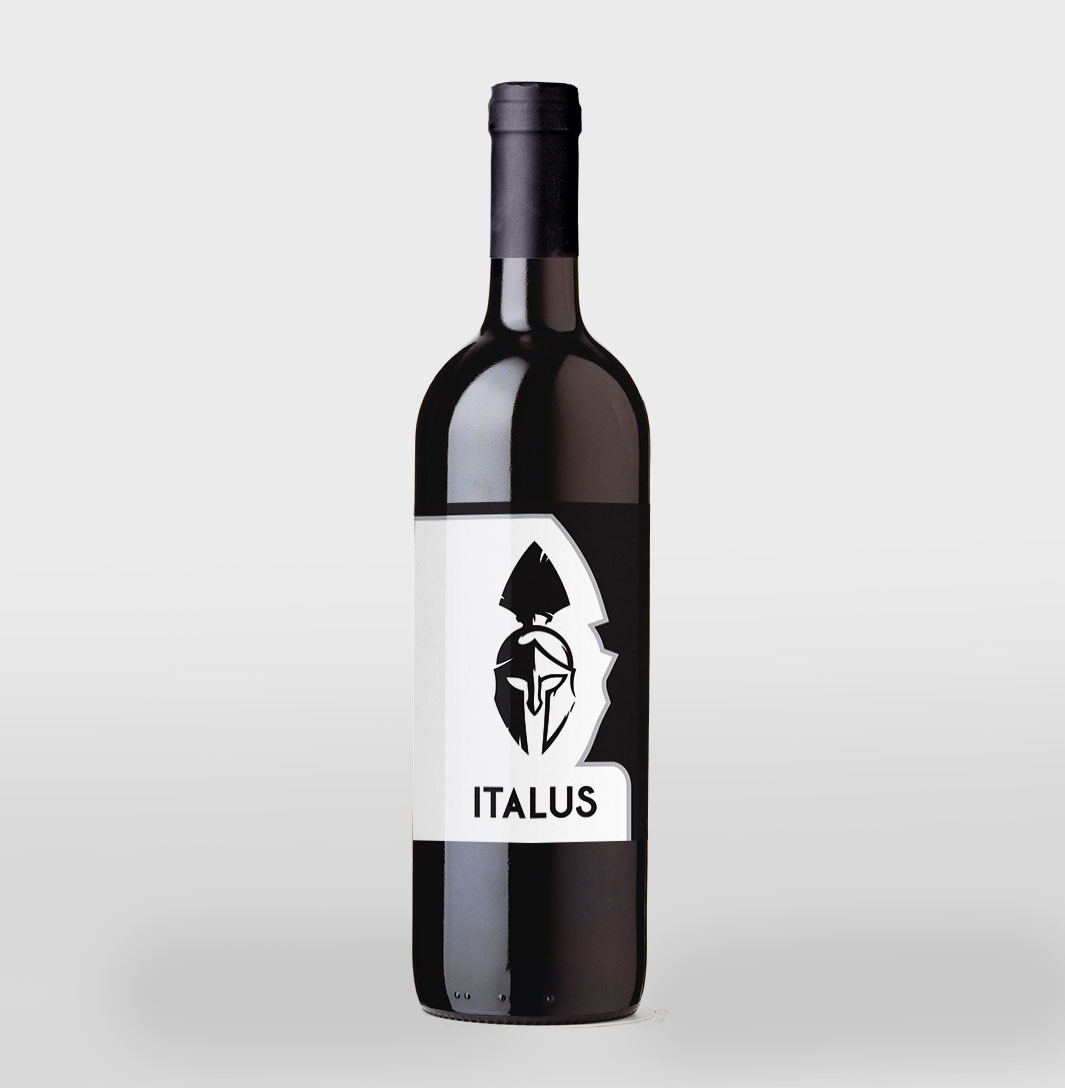 Finally,
we searched out a wine called Italus, the first
Nebbiolo- based wine to come out of Quebec
province. Carone
Wines, founded by Pietro Carone and since
his passing, run by his son Anthony, pioneered the
cultivation of vinifera grapes in Quebec in the
early 1990’s, and he is now considered an expert
in cold-climate grape growing. The 2015, just
recently released, is the first vintage of Italus,
following on the success of the winery’s cabernet
sauvignon and its pinot noir.
Finally,
we searched out a wine called Italus, the first
Nebbiolo- based wine to come out of Quebec
province. Carone
Wines, founded by Pietro Carone and since
his passing, run by his son Anthony, pioneered the
cultivation of vinifera grapes in Quebec in the
early 1990’s, and he is now considered an expert
in cold-climate grape growing. The 2015, just
recently released, is the first vintage of Italus,
following on the success of the winery’s cabernet
sauvignon and its pinot noir.
Aged for a year in stainless
steel and then for an additional one in medium
toast French oak, the wine is all about youthful
exuberance. In the glass, Italus is a vivid,
limpid, ruby-red color, with a nose of bright red
fruits with a touch of smoke and spice; the red
cherry flavors are pronounced without being sweet.
Bright acidity gives it freshness; an overlay of
sweet smoke softens the edges, and fine-grained
tannins introduce the finish. This delicious,
medium-bodied wine begs for food to show at its
best; it’s also a bargain at $23.
❖❖❖
By John Mariani

330 Malcolm X Boulevard (off
Bainbridge Street)
Brooklyn
929-210-0589
A stretch
of Malcolm X Boulevard in Brooklyn’s quickly
gentrifying Bedford-Stuyvesant neighborhood is
becoming something of a Restaurant Row, with
more than a dozen spots well worth knowing
about, from coffee shops to Italian
restaurants, from soul food eateries to
Southern bakeries.
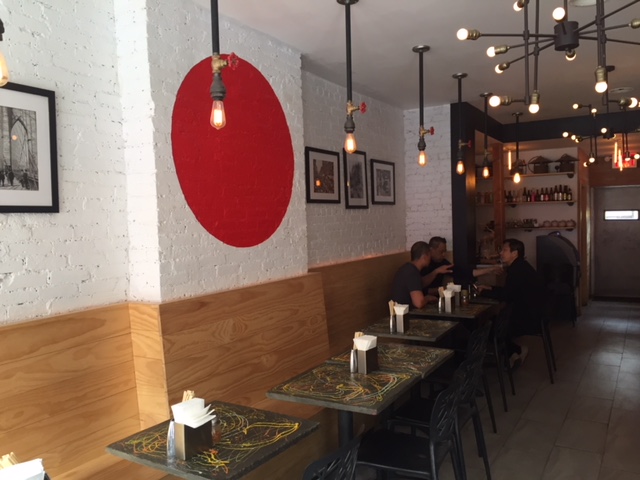 One of the
best of the storefronts is Nana Ramen (there’s
another elsewhere in Brooklyn, both owned by
Eric Ong), a slip of a room with an outdoor
patio just now being put to good use as spring
struggles to settle in.
One of the
best of the storefronts is Nana Ramen (there’s
another elsewhere in Brooklyn, both owned by
Eric Ong), a slip of a room with an outdoor
patio just now being put to good use as spring
struggles to settle in.
The room itself is fairly
barren of décor aside from wood wainscoting,
hanging filament lights and spidery chandeliers,
and a big red Japanese Rising Sun on a white
brick wall. The tables are bare but painted to
look as if Jackson Pollock had scribbled on them
while waiting for his food. The
service staff couldn’t be nicer.
The short menu lists ramen on
one side and small dishes on the other, all at
amazingly good prices, so we ordered several of
the latter and three of the former. Inari
sushi with seared eel ($8) is named after the
Shinto god of fertility,  rice and foxes, and
comes as a trio of tofu-wrapped pouches packed
with deliciously seasoned sweet eel and topped
with fried scallions. Karaage
chicken ($8), battered and seasoned with soy
sauce and garlic (right), was wonderfully crisp,
not unlike Cajun popcorn but with bigger pieces,
set atop a tamale-like corn husk and served with
a creamy dipping sauce and slice of lemon. The gyoza
($8) are irresistible pan-fried pork dumplings I
could eat platters of for a full meal. A
rich dashi
broth underpins a bowl of golden fried tofu
($7).
rice and foxes, and
comes as a trio of tofu-wrapped pouches packed
with deliciously seasoned sweet eel and topped
with fried scallions. Karaage
chicken ($8), battered and seasoned with soy
sauce and garlic (right), was wonderfully crisp,
not unlike Cajun popcorn but with bigger pieces,
set atop a tamale-like corn husk and served with
a creamy dipping sauce and slice of lemon. The gyoza
($8) are irresistible pan-fried pork dumplings I
could eat platters of for a full meal. A
rich dashi
broth underpins a bowl of golden fried tofu
($7).
An unusually good dish
unfamiliar to me was a Japanese egg pancake
called okonomiyaki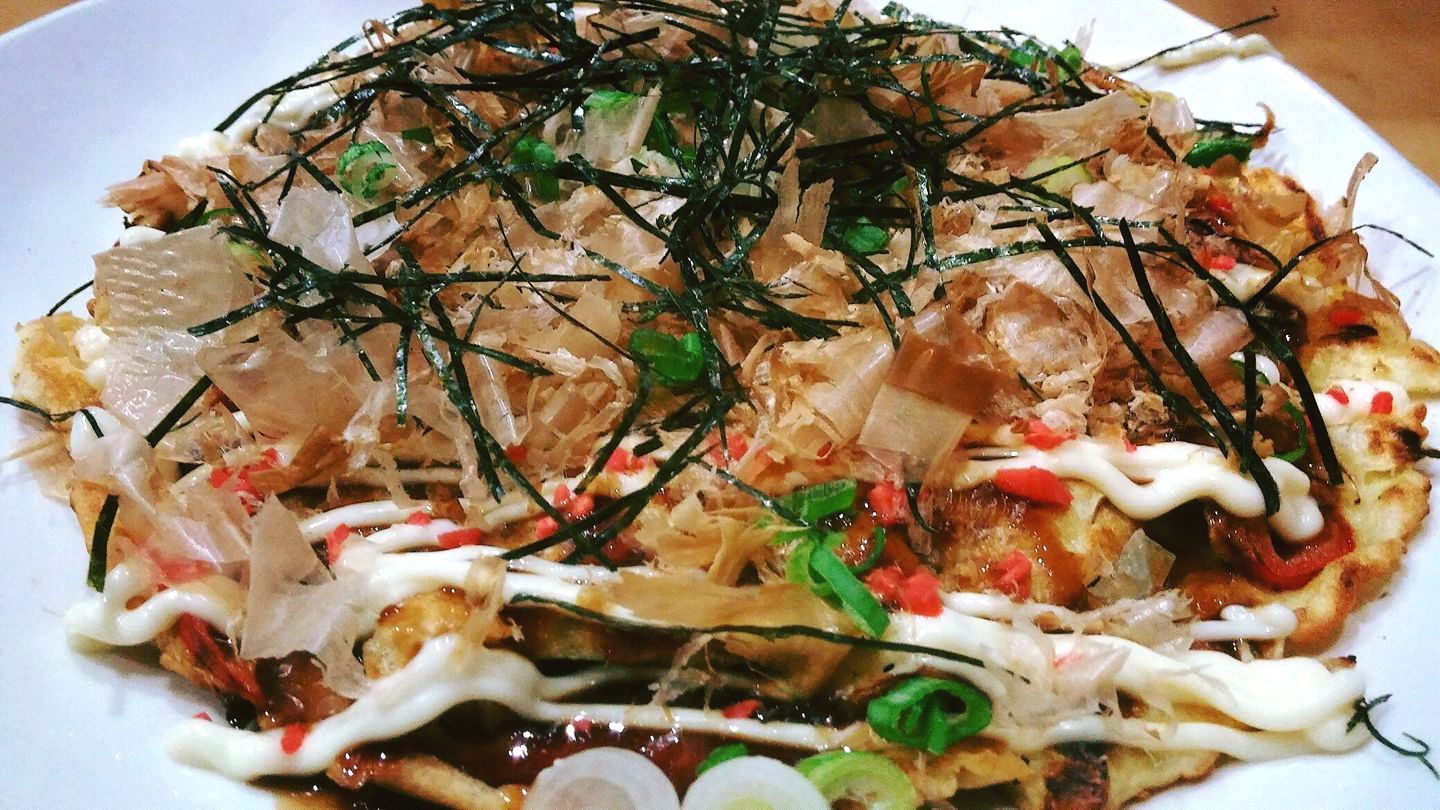 (okonomi means
“how you like it”), made with bonito, flour,
vegetables, seaweed and oyster sauce ($14).
Those flakes of bonito actually waft in the
steam of the dish, and it’s weird to watch.
(okonomi means
“how you like it”), made with bonito, flour,
vegetables, seaweed and oyster sauce ($14).
Those flakes of bonito actually waft in the
steam of the dish, and it’s weird to watch.
Good ramen
must begin with a good broth, not overly
seasoned or overly salted, with slightly chewy
noodles; from there the rest of the ingredients
build on those requisites. Nana’s ramens succeed
on all counts, whether it’s the spicy miso with
corn, bok choy, scallions and chashu
braised pork belly ($13); tan tan
of minced pork, scallions, sesame and bean
sprouts that packs a little punch from chile
($11); or yasai
shoyu, teeming with vegetables like
arugula, scallions, bean sprouts and baby bok
choy ($11).
You may request additional toppings
($1-$3), but that would be gilding the lily.
Japanese beer or sake goes
splendidly with this food, and Nana carries an
array.
It’s a cash-only business
but, this being 2018, they have an ATM in the
back.
Open daily for lunch and dinner.
❖❖❖
By Geoff Kalish
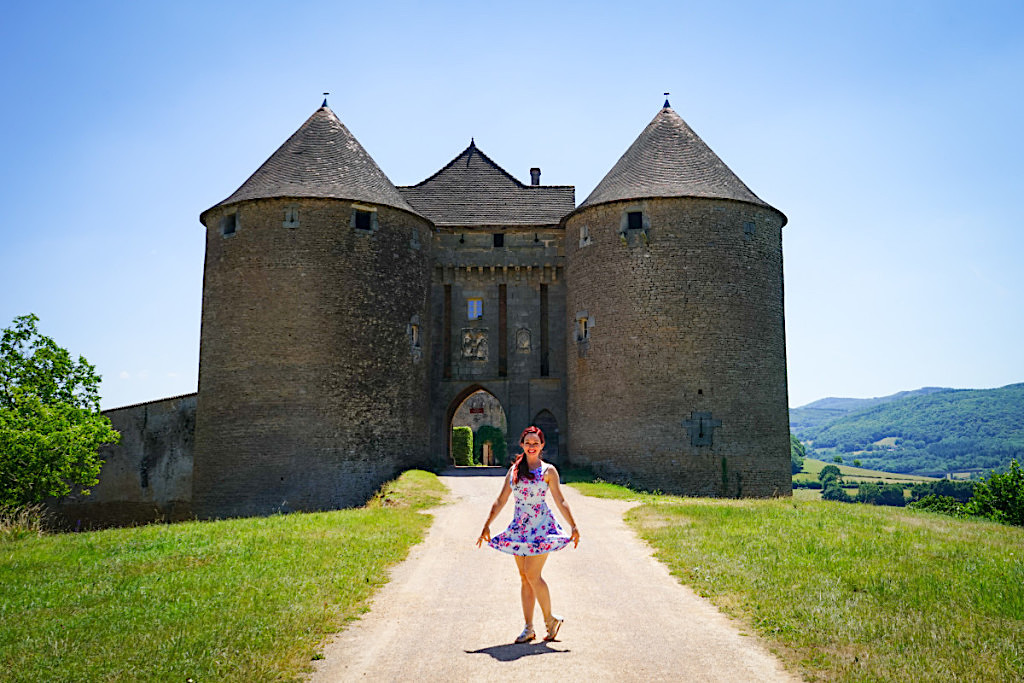
It’s said about California wines
that the only reason to know the vintage date of
a bottle is to figure out who made the wine at a
particular winery, since the California weather
is more stable than the position of winemaker,
who are often “drafted and signed” by facilities
like prized sports figures.
Whether that’s fact or merely
witticism, the situation with the quality and
quantity of wine from a particular vintage in
France, particularly in Burgundy, is certainly
more dependent on the vagaries of the year-to-year
changes in weather, with the same winemaker at the
same facility for long periods of time. With that
in mind, the Wine Media Guild (a New York-based
organization of professional wine communicators)
sought to determine the quality of the 2015
vintage of Burgundy with a luncheon tasting at
Manhattan’s Il Gattopardo of 14 whites and an
equal number of
reds from a widespread range of Burgundian
locales.
Overall, the consensus was that
this was an excellent year for Burgundian wines,
with the whites ready to drink now or in the next
few years, since the climactic conditions
generally produced ripe, full-flavored Chardonnay
grapes with less acidity than found in a number of
other recent harvests. On the other hand, these
same weather conditions also allowed the Pinot
Noir to ripen fully, yielding red wines best to
consume a few years from now and expected to be
quite long-lasting. Unfortunately, these days most
good Burgundies are not geared to the faint of
wallet, so in order to guide consumers about
purchasing these wines, the following are my notes
on what I considered the top ten bottles
presented.
Whites
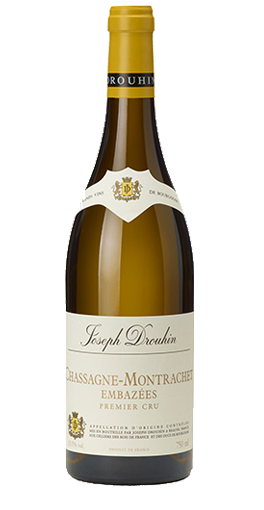 Château
Fuissé Pouilly-Fuissé “Les Clos” Propriatire
Récolant ($64)—Made
from Chardonnay grapes grown on a vineyard with
vines dating to 1929, this wine had a bouquet and
rich taste of apples and honey with notes of
almonds and hints of apricots and orange in its
long finish. It’s an ideal white to mate with
risotto or roasted chicken.
Château
Fuissé Pouilly-Fuissé “Les Clos” Propriatire
Récolant ($64)—Made
from Chardonnay grapes grown on a vineyard with
vines dating to 1929, this wine had a bouquet and
rich taste of apples and honey with notes of
almonds and hints of apricots and orange in its
long finish. It’s an ideal white to mate with
risotto or roasted chicken.
Bouchard Père
& Fils Chevalier Montrachet 1er Cru ‘La
Cabotte’ ($560)—While
a
bit much for most pocketbooks, this memorable wine
is aesthetically a cut or two above many of the
2015 white Burgundies. It has a distinctive
bouquet and taste of pears with hints of marzipan
and a touch of lime in its vibrant finish. Expect
it to drink well with the likes of lobster,
scallops, or tuna tartare for the next 5-10 years.
William Fèvre
Chablis Grand Cru Bougros “Côte Bouguerots”
($98)—This
full-bodied
wine, with a bouquet and taste of peaches and
citrus, has a crisp, fruity finish perfect to pair
with seafare, especially grilled dorade or
branzino.
Maison Joseph
Drouhin, Chassagne Montrachet, 1er Cru “Les
Embazées ($90)—Grapes
for
this wine hailed from vineyards noted for a
complex soil of limestone and clay. Following
harvest this wine was fermented using natural
yeast and aged for 12 months in French oak
barrels. It has a bouquet and taste of apples with
undertones of honeysuckle and hazelnuts and should
drink well over the next 10 years with ripe
cheeses and grilled seafare, particularly
swordfish or tuna.
Domaine Laroche
1er Cru Les Vaillons Vielles Vignes Chablis
($41)—Very
well
priced for a Premier Cru Chablis, this wine is
made from grapes grown in a vineyard composed of
fossilized oyster shells. It shows a bouquet and
taste of apples and peaches with notes of apricots
and zesty lemon in its finish. Unlike many 2015
Chablis, this wine contains enough acidity to age
well and pairs perfectly with bivalves or
shellfish.
Reds
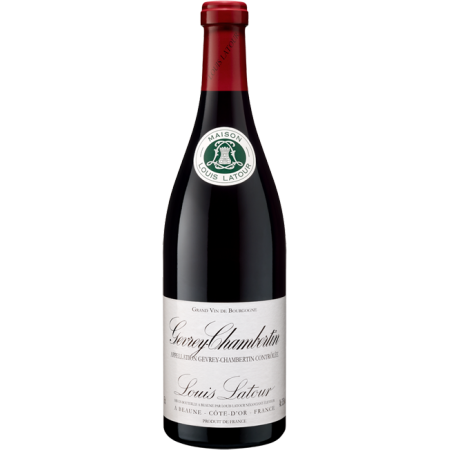 hints of
oak and earthy spices. And, while lighter in taste
than many other Nuit-St-George reds, it
harmoniously matches with lamb or veal and is
expected to gain complexity with a few years of
bottle age.
hints of
oak and earthy spices. And, while lighter in taste
than many other Nuit-St-George reds, it
harmoniously matches with lamb or veal and is
expected to gain complexity with a few years of
bottle age.
Domaine de
Bellene, Beaune 1er Cru Cuvée Cinquantenaire
($90)—This
blend
of grapes from five different premier cru Beaune
vineyards shows a bouquet and taste of plums with
notes of ripe cherries and toasty oak. A bit young
to drink now (although it marries well with
grilled lamb or beef), expect this wine to become
more complex and elegant with 5-10 years of bottle
age.
Louis Latour
Gevrey-Chambertin ($80)—Made
from hand-picked Pinot Noir grown on 30-year-old
vines in vineyards noted for chalk and limestone
soil, this wine was aged for a year in oak barrels
following fermentation. It has a distinct bouquet
and taste of black currants with notes of anise
and a smooth finish that mates well with grilled
chicken or ripe cheeses.
Vincent Giradin,
Santenay, Terre d’Enfance ($34)—A
good bargain, this hand-harvested Pinot Noir grown
in limestone-rich soil has a bouquet and taste of
fresh strawberries and plums with hints of almonds
in its smooth finish. It makes a good wine to
match with summertime barbecue, especially grilled
ribs, chicken or hamburgers.
Domaine Antonin
Guyon, Savigny-Les-Beaunes ‘Les Goudelettes’
($40)—This
well-priced
wine was made from hand-harvested Pinot Noir
fermented over 15 days in open vats and aged in
oak barrels (15% new) over 15 months. It shows a
fruity bouquet and taste of ripe plums and
blueberries with a long, smooth finish that
matches well with duck or grilled pork.
Wine
Column Sponsored by Banfi Vintners
SANGIOVESE
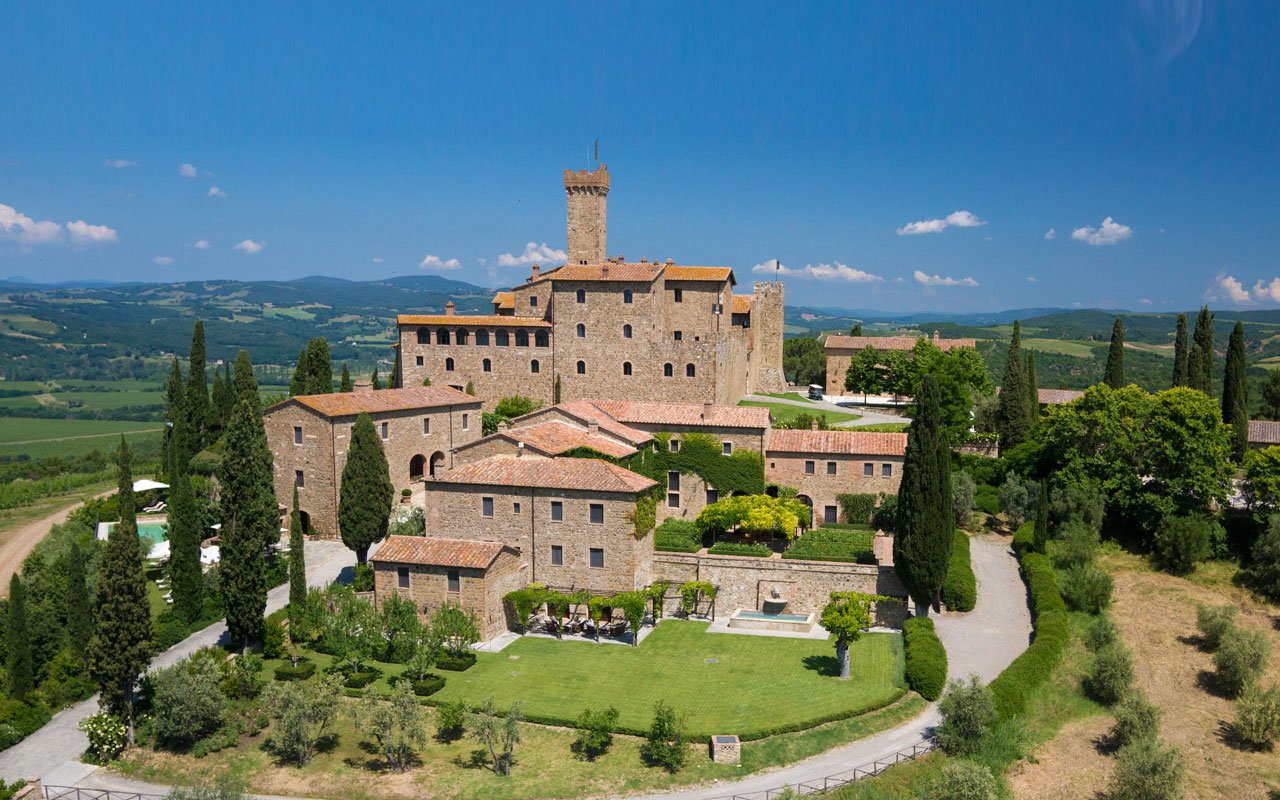 Wine is a joy year-round but
in cooler weather one
grape varietal has really taken center stage in
my daily activities – that most Italian of
grapes, Sangiovese, and its ultimate expression
– Brunello di Montalcino.
Wine is a joy year-round but
in cooler weather one
grape varietal has really taken center stage in
my daily activities – that most Italian of
grapes, Sangiovese, and its ultimate expression
– Brunello di Montalcino.
From mid-September through mid-October,
the Sangiovese grown for our various styles of red
wines are be harvested, culminating with the top
selection for Brunello di Montalcino.
Second, cooler weather here means
it is time to start enjoying more red wines and
especially Sangiovese based wines. That
includes Banfi’s cru of Brunello, Poggio alle Mura,
literally the cream of the crop of our Sangiovese
vineyards. Alongside our Poggio alle Mura Brunello di
Montalcino, this year we introduced two more wines
from the cru Poggio alle Mura – a Rosso di Montalcino
and a Riserva of Brunello. Rosso is sort of like the
younger brother of Brunello, also made from 100%
Sangiovese grapes but usually a selection from younger
vines and the wine is aged only two years compared to
the four required for Brunello. The
Riserva, on the other hand, is an even more selective
harvest of Sangiovese, and ages for an additional year
before release.
What is so special about this cru
Poggio alle Mura?
Well, it is the result our over 30 years of
ongoing research at my family’s vineyard estate,
Castello Banfi.
When we first began planting our vines there in
the late 1970s studies from the University of Bordeaux
indicated which strains of many varietals we should
plant, based on the soil type and microclimate of each
vineyard. But
when it came to the region’s native Sangiovese, there
was only local lore, no scientific research. So we took
it upon ourselves to figure out this vine, and set off
on three decades of incredibly detailed research.
We started
with 600 apparent variations on Sangiovese, because it
is so susceptible to variations in weather and soil,
and narrowed that down to 160 truly genetically
different clones.
We planted a vineyard with two rows of each
type, made wine from each of them, and charted the
differences – remember, you only get one chance a year
to make wine, so this took time.
It took about ten years to get some
concrete results, though we continue to experiment
today and always will – you never stop learning in
science and nature!
Once we determined which were the best,
complementary clones that could be planted together to
make the best Brunello, we chose to plant them in what
we determined to be the optimal vineyard sites. Coincidentally,
the best soils and climate conditions are in the
slopes surrounding the medieval fortress today known
as Castello Banfi, known since Etruscan times as
Poggio alle Mura – the walled hilltop. Hence the
name of our most special “cru” of Brunello,
representing a synthesis between tradition and
innovation.
Though the focus of this study was
our Brunello, all of our Sangiovese-based wines,
including the super Tuscans SummuS, Cum Laude, and
Centine, benefited from this work. And that’s
the third reason for celebrating Sangiovese this
month, for the range of wonderful reds that usher us
into autumn! One
wine in particular was inspired by our research – the
BelnerO, a Sangiovese dominant blend with what I like
to call a kiss of Cabernet and a whisper of Merlot. We grow the
grapes a little differently for BelnerO than for
Brunello, make the wine with less oak aging and
released it earlier from the winery, providing a
counterpoint to Brunello and a lovely terroir-driven
wine in its own right.
If you
know Italians, you know that by nature we are
multi-faceted, varying in mood, and always passionate. As a
nation, we span from the hot sunny beaches of Sicily
near the African coast to the rugged mountains and
Alpine ski slopes of Trentino-Alto Adige in the north. Sangiovese
is grown in almost all of Italy’s regions and reflects
the unique nature of each; it is most famous
(rightfully so) in Tuscany, yet even there it reflects
the nuances of each hilltop, valley and subzone. It has
something a little different to say in Brunello than
Chianti, Morellino than Vino Nobile di Montepulciano,
Rosso di Montalcino than Super Tuscan blends.
Here is a smattering of
Sangiovese-based wines that you may wish to get to
know better, reflecting a spectrum that appeals to
every occasion, every taste, and every budget. We can
assure you that the conversation will never become
boring. 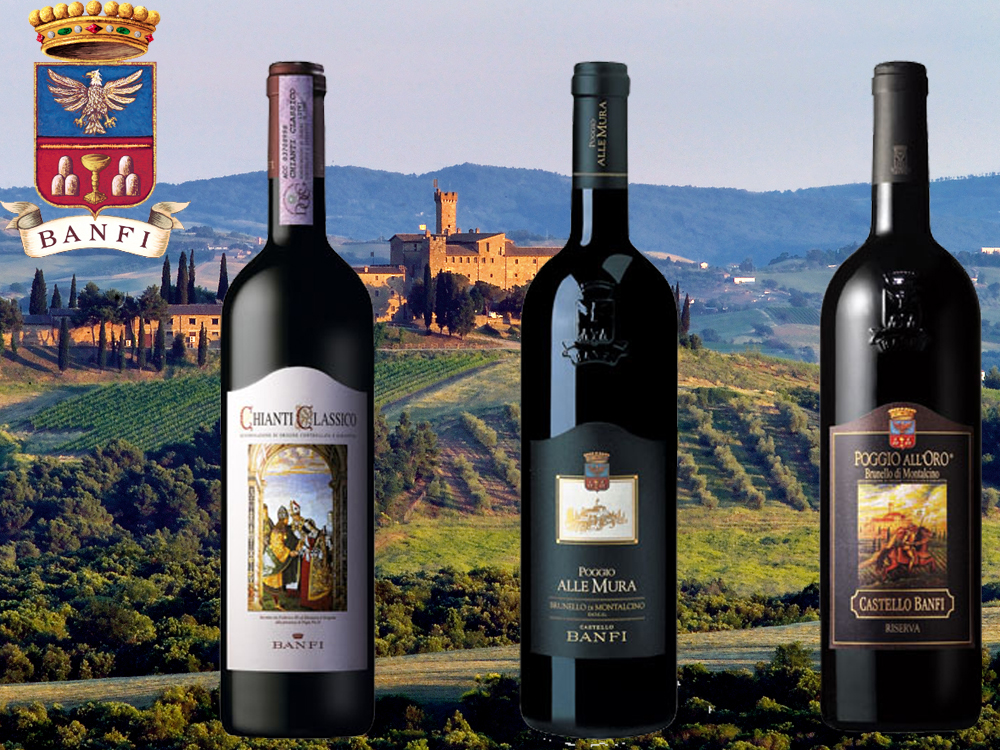
Recommendations for Celebrating
Sangiovese
BelnerO Proprietor’s Reserve Sangiovese
– A refined
cuvée of noble red grapes perfected by our pioneering
clonal research. This dark beauty, BelnerO, is
produced at our innovative winery, chosen 11
consecutive years as Italy’s Premier Vineyard Estate.
Fermented in our patented temperature controlled
French oak and aged approximately 2 additional years.
Unfiltered, and Nitrogen bottled to minimize sulfites.
Castello Banfi Brunello di Montalcino –
Rich, round, velvety and intensely
aromatic, with flavor hints of licorice, cherry, and
spices. Brunello di Montalcino possesses an intense
ruby-red color, and a depth, complexity and opulence
that is softened by an elegant, lingering aftertaste.
Unfiltered after 1998 vintage.
Castello Banfi Rosso di Montalcino – Brunello's "younger brother," produced
from select Sangiovese grapes and aged in barrique for
10 to 12 months. Deep ruby-red, elegant, vibrant,
well-balanced and stylish with a dry velvety
finish.
Poggio all’Oro Brunello di Montalcino
Riserva – A single vineyard selection of our most
historically outstanding Sangiovese, aged five years
before release, the additional year more than that
required of Brunello including 6 months in barrel and
6 months more in bottle to grant its “Riserva”
designation. Incredible
elegance and harmony. Intense with lots of fruit and
subtle wood influence. Round, complete, well balanced
with hints of chocolate and berries. Unfiltered after
1998.
Poggio alle Mura – The first tangible result of years of
intensive clonal research on Montalcino’s native
Sangiovese grape.
Estate bottled from the splendidly sun drenched
vineyards surrounding the medieval Castello from which
it takes its name.
The Brunello
di Montalcino is seductive, silky and smoky. Deep ruby
in color with an expressive bouquet of violets, fruits
and berries as well as cigar box, cedar and exotic
spices. The Rosso
di Montalcino is also intense ruby red. The bouquet
is fresh and fruity with typical varietal notes of
cherry and blackberry, enriched by more complex hints
of licorice, tobacco and hazelnut. It is full
bodied, yet with a soft structure, and a surprisingly
long finish. The Poggio alle Mura Brunello di Montalcino
Riserva is deep ruby red with garnet
reflections and a rich, ample bouquet that hints of
prune jam, coffee, cacao and a light balsamic note. It is full
and powerful, with ripe and gentle tannins that make
it velvety and harmonious; this wine is supported by a
pleasing minerality that to me speaks soundly of that
special hillside in southern Montalcino.
SummuS – A wine of towering elegance, SummuS is an
extraordinary blend of Sangiovese which contributes
body; Cabernet Sauvignon for fruit and structure; and
Syrah for elegance, character and a fruity bouquet. An elegant,
complex and harmonious red wine.
Cum Laude – A complex and elegant red which graduated
“With Honors,” characterized by aromas of juicy
berries and fresh spices.
Centine – A Cuvee that is more than half
Sangiovese, the balanced consisting of equal parts of
Cabernet Sauvignon and Merlot. Vinified in
a firm, round style that easily accompanies a wide
range of dishes, this is a smooth and fragrantly
satisfying wine with international character, and a
perennial favorite at my own dinner table.
Banfi Chianti Superiore – The “Superiore” designation signifies
stricter government regulations regarding production
and aging requirements, as compared to regular
Chianti. An
intense ruby red wine with fruit forward aromas and
floral notes. This
is a round wine with well-balanced acidity and fruit.
Banfi Chianti Classico – An enduring classic: alluring
bouquet of black fruit and violets; rich flavors of
cherry and leather; supple tannins and good acidity
for dining.
Banfi Chianti Classico Riserva – Produced from select grapes grown in the
"Classico" region of Chianti, this dry, fruity and
well-balanced red has a full bouquet reminiscent of
violets.
Fonte alla Selva Chianti Classico – This is our newest entry into the Chianti
arena, coming from a 99 acre estate in Castellina, the
heart of the Chianti Classico region. The wine is
a captivating mauve red that smells of cherry, plum
and blackberry with hints of spice. It is
round, full and balanced with very good
acidity.
Col di Sasso – Sangiovese and Cabernet Sauvignon. Luscious,
complex and soft with persistent notes of fruit and
great Italian style structure.
Any of John Mariani's books below may be ordered from amazon.com.
 The Hound in Heaven
(21st Century Lion Books) is a novella, and
for anyone who loves dogs, Christmas, romance,
inspiration, even the supernatural, I hope you'll find
this to be a treasured favorite. The story
concerns how, after a New England teacher, his wife and
their two daughters adopt a stray puppy found in their
barn in northern Maine, their lives seem full of promise.
But when tragedy strikes, their wonderful dog Lazarus and
the spirit of Christmas are the only things that may bring
his master back from the edge of despair.
The Hound in Heaven
(21st Century Lion Books) is a novella, and
for anyone who loves dogs, Christmas, romance,
inspiration, even the supernatural, I hope you'll find
this to be a treasured favorite. The story
concerns how, after a New England teacher, his wife and
their two daughters adopt a stray puppy found in their
barn in northern Maine, their lives seem full of promise.
But when tragedy strikes, their wonderful dog Lazarus and
the spirit of Christmas are the only things that may bring
his master back from the edge of despair. WATCH THE VIDEO!
“What a huge surprise turn this story took! I was completely stunned! I truly enjoyed this book and its message.” – Actress Ali MacGraw
“He had me at Page One. The amount of heart, human insight, soul searching, and deft literary strength that John Mariani pours into this airtight novella is vertigo-inducing. Perhaps ‘wow’ would be the best comment.” – James Dalessandro, author of Bohemian Heart and 1906.
“John Mariani’s Hound in Heaven starts with a well-painted portrayal of an American family, along with the requisite dog. A surprise event flips the action of the novel and captures us for a voyage leading to a hopeful and heart-warming message. A page turning, one sitting read, it’s the perfect antidote for the winter and promotion of holiday celebration.” – Ann Pearlman, author of The Christmas Cookie Club and A Gift for my Sister.
“John Mariani’s concise, achingly beautiful novella pulls a literary rabbit out of a hat – a mash-up of the cosmic and the intimate, the tragic and the heart-warming – a Christmas tale for all ages, and all faiths. Read it to your children, read it to yourself… but read it. Early and often. Highly recommended.” – Jay Bonansinga, New York Times bestselling author of Pinkerton’s War, The Sinking of The Eastland, and The Walking Dead: The Road To Woodbury.
“Amazing things happen when you open your heart to an animal. The Hound in Heaven delivers a powerful story of healing that is forged in the spiritual relationship between a man and his best friend. The book brings a message of hope that can enrich our images of family, love, and loss.” – Dr. Barbara Royal, author of The Royal Treatment.
 |
The Encyclopedia of American Food and Drink by John F. Mariani (Bloomsbury USA, $35) Modesty forbids me to praise my own new book, but let me proudly say that it is an extensive revision of the 4th edition that appeared more than a decade ago, before locavores, molecular cuisine, modernist cuisine, the Food Network and so much more, now included. Word origins have been completely updated, as have per capita consumption and production stats. Most important, for the first time since publication in the 1980s, the book includes more than 100 biographies of Americans who have changed the way we cook, eat and drink -- from Fannie Farmer and Julia Child to Robert Mondavi and Thomas Keller. "This book is amazing! It has entries for everything from `abalone' to `zwieback,' plus more than 500 recipes for classic American dishes and drinks."--Devra First, The Boston Globe. "Much needed in any kitchen library."--Bon Appetit. |
"Eating Italian will never be the same after reading John Mariani's entertaining and savory gastronomical history of the cuisine of Italy and how it won over appetites worldwide. . . . This book is such a tasteful narrative that it will literally make you hungry for Italian food and arouse your appetite for gastronomical history."--Don Oldenburg, USA Today. "Italian
restaurants--some good, some glitzy--far
outnumber their French rivals. Many of
these establishments are zestfully described
in How Italian Food Conquered the World, an
entertaining and fact-filled chronicle by
food-and-wine correspondent John F.
Mariani."--Aram Bakshian Jr., Wall Street
Journal.
"Equal parts
history, sociology, gastronomy, and just
plain fun, How Italian Food Conquered the
World tells the captivating and delicious
story of the (let's face it) everybody's
favorite cuisine with clarity, verve and
more than one surprise."--Colman Andrews,
editorial director of The Daily
Meal.com. "A fantastic and fascinating
read, covering everything from the influence
of Venice's spice trade to the impact of
Italian immigrants in America and the
evolution of alta cucina. This book will
serve as a terrific resource to anyone
interested in the real story of Italian
food."--Mary Ann Esposito, host of PBS-TV's
Ciao
Italia. "John Mariani has written the
definitive history of how Italians won their
way into our hearts, minds, and
stomachs. It's a story of pleasure over
pomp and taste over technique."--Danny Meyer,
owner of NYC restaurants Union Square
Cafe, The Modern, and Maialino.
|
 |
 |
 |
 |
 |
 |
 |
 |
 Everett Potter's Travel Report:
Everett Potter's Travel Report: 
 Eating Las Vegas
JOHN CURTAS has been covering the Las Vegas
food and restaurant scene since 1995. He is
the co-author of EATING LAS VEGAS – The 50
Essential Restaurants (as well as
the author of the Eating Las Vegas web site: www.eatinglasvegas.
He can also be seen every Friday morning as
the “resident foodie” for Wake Up With the
Wagners on KSNV TV (NBC) Channel 3 in
Las Vegas.
Eating Las Vegas
JOHN CURTAS has been covering the Las Vegas
food and restaurant scene since 1995. He is
the co-author of EATING LAS VEGAS – The 50
Essential Restaurants (as well as
the author of the Eating Las Vegas web site: www.eatinglasvegas.
He can also be seen every Friday morning as
the “resident foodie” for Wake Up With the
Wagners on KSNV TV (NBC) Channel 3 in
Las Vegas.
MARIANI'S VIRTUAL GOURMET
NEWSLETTER is published weekly. Editor/Publisher: John
Mariani.
Editor: Walter Bagley. Contributing Writers: Christopher Mariani,
Robert Mariani, Misha Mariani, John A. Curtas, Geoff Kalish, and Brian Freedman. Contributing
Photographer: Galina Dargery. Technical
Advisor: Gerry
McLoughlin.
If you wish to subscribe to this
newsletter, please click here: http://www.johnmariani.com/subscribe/index.html
© copyright John Mariani 2017

